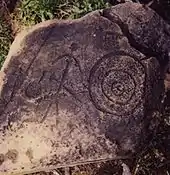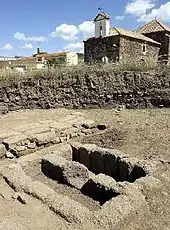Almodóvar del Campo
Almodóvar del Campo is a municipality of Spain, located in the province of Ciudad Real, autonomous community of Castilla–La Mancha.[3] Featuring a total area of 1.208,25 km2,[3] it is the largest municipality in the region and one of the largest municipalities in Spain.[4][5] As of 1 January 2020, it had a population of 5,983.[3]
Almodóvar del Campo | |
|---|---|
 | |
.svg.png.webp) Coat of arms | |
Location of Almodóvar del Campo | |
| Coordinates: 38°43′7″N 4°10′0″W | |
| Country | Spain] |
| Autonomous community | Castilla–La Mancha |
| Province | Ciudad Real |
| Area | |
| • Total | 1,208.25 km2 (466.51 sq mi) |
| Elevation | 669 m (2,195 ft) |
| Population (2018)[1] | |
| • Total | 6,139 |
| • Density | 5.1/km2 (13/sq mi) |
| Demonyms | Almodovareño, almodoveño[2] |
| Time zone | UTC+1 (CET) |
| • Summer (DST) | UTC+2 (CEST) |


Geography
It lies some 14 km S.S.W. of the provincial capital, on the northern side of the Sierra de Alcudia. The city lies at about 669 metres above mean sea level.[6]
History
The former settlement of Sisapo has been identified as the La Bienvenida archaeological site, which is located near the hamlet of the same name.[7] The foundation mark has been pushed back to the late-8th to early-7th centuries BC.[7] There is doubt on whether Sisapo was an Oretani city, although Plinius presented it as a Turduli city.[8] Sisapo thrived during the Roman era on the basis of the exploitation of cinnabar, a mercury ore.[9] The mines decreased in activity by the late-2nd to early-3rd centuries AD.[10]
The etymological origin of Almodóvar is the Arabic al-mudawwar, meaning 'the round (one)'.[11] In the mid-12th century, the forces of Munio Alfonso handed a blow to the Saracen forces of Texufin in the plains of Almodóvar.[12]
Part of the Order of Calatrava's dominion in the Meseta Sur, the Campo de Calatrava, Almódovar became the headquarters of one of the order's largest encomiendas, and its economy thrived throughout the late middle ages thanks to the pastures.[13] Almodóvar celebrated two fairs (created towards 1260), which eventually became a weekly open market from 1376 onward.[13] Over the late middle ages, Almodóvar had minorities of judeoconversos, mudéjares and foreigners (Genoese, Portuguese, Flemish and French).[14] Created towards 1456, in the context of the Calatravan interests to guarantee safety from banditry in the area as well as to curb the influence of the Hermandad de Ciudad Real, the so-called Santa Hermandad Vieja de Almodóvar del Campo came to exert judicial and policial powers in the area for centuries.[15]
On the eve of the 1855 desamortización, the municipality of Almodóvar had 78,892.55 hectares of publicly-owned monte.[4] All of them were privatized between 1896 and 1897.[4]
The mining of Almodóvar's oil shale resources fostered the 20th-century industrial development of neighbouring Puertollano.[16]
References
- Citations
- Municipal Register of Spain 2018. National Statistics Institute.
- Núñez 2004, p. 1047–1056.
- "Datos del Registro de Entidades Locales". Ministerio de Asuntos Económicos y Transformación Digital. Retrieved 18 July 2021.
- Cendrero 2014, p. 91.
- Valle Calzado 2016, p. 114.
- "Predicción por municipios. Almodóvar del Campo (Ciudad Real)". AEMET. Retrieved 18 July 2021.
- Zarzalejos Prieto et al. 2020, p. 308.
- Luján 2013, p. 120.
- Zarzalejos Prieto et al. 2020, p. 307.
- Zarzalejos Prieto et al. 2020, p. 308–309.
- Martínez Ruiz 1988, p. 119.
- Barton & Fletcher 2000, p. 233.
- Gómez Vozmediano 1999, p. 109.
- Gómez Vozmediano 1999, p. 110.
- Gómez Vozmediano 1999, p. 130.
- Pieren Vidal 2009, p. 127.
- Bibliography
- Barton; Fletcher (2000). The World of El Cid: Chronicles of the Spanish Reconquest. Manchester University Press. ISBN 0-7190-5225-4.
- Cendrero, Vicente (2014). "¿Privatización o expolio? La desamortización del monte público en Almodóvar del Campo, Ciudad Real (1845-1897)" (PDF). Historia Agraria. Sociedad de Estudios de Historia Agraria: 89–114. ISSN 1139-1472.
- Luján, Eugenio R. (2013). "La situación lingüística de la Meseta Sur en la Antigüedad". Palaeohispanica. Revista sobre Lenguas y Culturas de la Hispania Antigua. Zaragoza: Institución Fernando el Católico (13): 103–136. ISSN 1578-5386.
- Gómez Vozmediano, Miguel Fernando (1999). "Una corte rural de justicia: La Santa Hermandad Vieja de Almodóvar del Campo (1456-1808)". Cuadernos de Historia Moderna. Madrid: Ediciones Complutense. 22: 107. ISSN 0214-4018.
- Martínez Ruiz, Juan (1988). "Contribución al estudio de la toponimia medieval de Castilla-La Mancha". I Congreso de Historia de Castilla-La Mancha (PDF). Vol. V. Servicio de Publicaciones de la Junta de Comunidades de Castilla-La Mancha. pp. 117–125. ISBN 84-7788-005-0.
- Núñez, Luis Pablo (2004). "La morfología derivativa en los gentilicios del español" (PDF). Interlingüística. 15 (2): 1047–1056. ISSN 1134-8941.
- Pieren Vidal, Agustín Pedro (2009). "Rasgos geológicos de la comarca de Puertollano y del valle de Alcudia (Ciudad Real, España)". In Costa, Margarita; Pieren, Agustín; Viejo, José Luis (eds.). Historia Natural de Puertollano y el Campo de Calatrava (PDF). Madrid: Real Sociedad Española de Historia Natural. pp. 95–133. ISBN 978-84-936677-3-3.
- Valle Calzado, Ángel Ramón del (2016). "Estrategias y actitudes del poder local ante la privatización de las tierras concejiles en la España interior (Ciudad Real, 1855-1910)" (PDF). Historia Agraria. Sociedad Española de Historia Agraria: 105–135.
- Zarzalejos Prieto, Mar; Esteban Borrajo, Germán; Hevia Gómez, Patricia; Pina Burón, María Rosa (2020). "Celeberrimo Sisaponensi regione in Baetica miniariometallo... Vías de investigación sobre el cinabrio hispano en época romana". Anejos a Cuadernos de Prehistoria y Arqueología. Madrid: UAM Ediciones (4): 307–316. doi:10.15366/ane4.ochoa2020.024. hdl:2072/443457. S2CID 228995674.